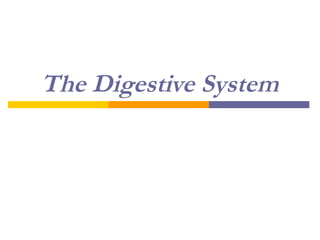
The digestive system
- 2. Nutrition Nutrition is the study of how food affects the function of living organisms. Food contains nutrients. If cells don’t have nutrients, they don’t function correctly. Poor diet = poor cells. There are six general categories of nutrients.
- 3. Six Nutrient Categories Energy Regulatory Suppliers Nutrients Carbohydrates Water Lipids Vitamins Proteins Minerals
- 4. 2 Factors leading to Nutritional Problems 1) too little physical activity (sedentary lifestyle) 2) Over consumption of food Leads to obesity
- 5. The Digestive System System is responsible for breaking down food so that it can be absorbed by the bloodstream. The “alimentary canal” is the pathway which food travels through the digestive system.
- 6. The Alimentary Canal Mouth Esophagus 26 ft long!!!!!!! Stomach Small intestine Large intestine Rectum * The liver, pancreas, and gallbladder are parts of the digestive system but are not parts of the alimentary canal.
- 8. The Mouth Chemical (saliva) and mechanical (chewing) digestion occur in the mouth. Salivary glands produce saliva. Saliva lubricates food. Saliva contains enzyme amylase (starch digestion).
- 9. Esophagus 9.8 in Muscular tube. Leads from back of throat (pharynx) to the stomach. Opening to trachea (tube) and esophagus (soft) are right next to each other. Epiglottis prevents food from going down the wrong tube. Muscular contractions (peristalsis) pushes food down the esophagus.
- 10. Stomach 4 hours Responsible for protein digestion. Chemical and mechanical digestion. Hydrochloric acid and pepsin (enzyme) break down proteins into amino acids. (pH 1.5-2.5) Stomach lining contains mucus. Mucus protects stomach from acid. Ulcers Sphincter muscles (cardiac and pyloric) control what enters and leaves the stomach.
- 11. Small Intestine 20 ft. long. The first part of the small intestine is called the “duodenum.” Remaining carbo’s and proteins are broken down. All lipids are digested in S.I. Gall bladder. (stores bile from the liver & delivers to the S.I.) Duodenum connects to liver and pancreas.
- 12. Liver and Pancreas Secrete Digestive Enzymes LIVER JOBS PANCREAS JOBS Detoxifies drugs and Regulates blood alcohol sugar. Secretes bile into Releases digestive duodenum. enzymes into Bile breaks down duodenum. lipids. Neutralizes stomach Bile is stored in the acid before it enters gall bladder. S.I.
- 13. Small Intestine (cont.) After all nutrients are digested from food, they are absorbed into the blood. S.I. contains lots of capillaries. Mesentary.
- 14. Large Intestine All proteins, carbos, and lipids have been removed from food by the time it gets here. Water in food is absorbed into the blood. Vitamins are absorbed into the blood. Whatever food is left is “fecal” matter and passes out the rectum and anus. Feces is undigested food.
- 15. Excretory System Kidney Clean the blood Vital role in maintaining homeostasis Removes waste Regulate amount of water in blood Nephrons- blood cleaning units Forms urine Urine contains nitrogenous waste products, excess amounts of water and solutes. ~1 Liter of urine produced each day.
- 16. Reabsorption Returns important substances to the blood. Second process of urine formation
- 17. Kidney Disorders & Treatment ~ 13 million people suffer form kidney disorders in the US. Kidney stones- Uric or oxalic acid, calcium salts, etc. collect outside of kidneys Hemodialysis- Filtering of blood. Receive 2x’s a week